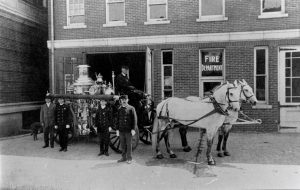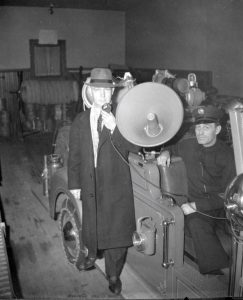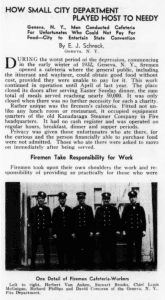“No one hungry in Geneva this winter:” Firemen’s Cafeteria
By Becky Chapin, Archivist
The 1930s in Geneva has mostly gone unnoted in our blog and exhibits. There isn’t a whole lot of archival material that has come out of that period either. There was a rise of photography in the late 1800s, that mostly fell off in the 1910s, but PB Oakley’s incredible photograph collection covers the 1940s-1960s very well. Bookended by the roaring twenties and the boom from World War II, how did Genevans experience the Great Depression?
At the height of the Depression in 1933, almost 13 million people were unemployed. Wages for those lucky enough to keep their jobs fell 42.5% between 1923 and 1933.[i]
The winter of 1932-33 was apparently predicted to be a difficult one locally. There was plenty of talk of panhandlers who would approach businesses and people to ask for money or food. Chief McGuigan advanced the plan to open a cafeteria to provide meals for the needy to the public welfare department and received approval. It was announced in the newspaper on October 22, 1932.
The Deputy Commissioner of Public Welfare Thomas J Comisky stressed the need for some means of conserving welfare funds and at the same time turning no one away who is hungry. Mayor Demming said, “There is a real need for something of this kind this coming winter.”
But how would they fund the cafeteria? Part of the plan was to give a benefit show that would be produced by a professional and called for local talent to audition. A committee was created, and Perrin G Somers was hired as the theatrical producer and director. Somers had staged 10 shows in Canandaigua, his summer residence, and his wife would assist him. The show would be staged at Schine’s Geneva Theatre.
Meanwhile, the firemen needed a location to set up the cafeteria. It was decided to use the former Kanadesaga Steamer Company building on Linden Street. Since the building was being used to store firefighting apparatus, it had to be cleaned up and transformed into a dining and kitchen space. Floors needed sanding and painting, and plumbing was needed.
The firemen worked hard to create a nice space. Within days of the plan’s announcement, they had received a large restaurant gas range from Empire Coke Co, a large refrigerator from Market Basket, and a restaurant counter and coffee percolator on loan from Charles Sweeney. Enameled tinware cups, saucers, plates, cooking pots and pans were purchased from the Lisk Company. Additional cutlery, tables and chairs were also supplied.
Farmers and other business owners started to donate vegetables, tons of cabbage, beans, potatoes and other foodstuffs for use in the cafeteria as well. It was important that the cafeteria provided a menu of simple, yet filling food; this would include plenty of stews with an occasional meat dish made from the less expensive cuts of beef and pork.
A month after the plan was announced, the cafeteria was ready to open and would serve three meals a day. It was run by the paid firemen, mostly drivers, alongside the volunteer firemen as needed. The first meal was on November 23 and was a hot vegetable soup, beef stew with onions, potatoes and carrots, coffee, bread, and an apple. The 55 attendees were fed second and, in some cases, third helpings. The dinner was mostly attended by locals, but transients were also present.
Chief McGuigan encouraged the public to point visitors to the cafeteria and assure them they would not be charged for the meal. He was quick to point out that though non-locals were welcome, they would not be encouraged to stay for more than a meal or two as it was not a boarding house.
The cafeteria was ready just in time for Thanksgiving, feeding 29 a good dinner with desserts supplied by a local restaurant. The main chef was Charles Lain, a Folger Hook and Ladder driver, with his wife helping. He was assisted by five paid drivers and tillermen, and the volunteer firemen who were unemployed or at leisure.
Meanwhile, the benefit was coming together nicely. With an admission fee of $1, tickets were selling all over Geneva and in neighboring communities. The Geneva Community Frolic was given on December 8 and 9 with a total of 80 local talent acts. It raised almost $3,000 and after expenses the cafeteria received $1,517.80 which was enough to get it through the winter months.
Additional donations came naturally through the community. The cafeteria received proceeds from events like basketball games, and from other events like when the St. Francis deSales Church Boy Scouts sent surplus food from an anniversary dinner. The NYS Experiment Station (now Cornell AgriTech) donated syrup and cocoa that had been originally sent to the Dairy Division for scientific analysis. Local businesses, organizations, and individuals continued to donate what they could spare, food or money.
In one month, the cafeteria served 4,288 meals! Dinners continued to draw the largest crowds, usually with over a thousand. The Cafeteria also provided meals for workers employed through the Welfare Council. And another outcome from this enterprise was that upwards of 50 children a day were able to leave school at noon and go to the cafeteria to receive a free meal that they would not otherwise have at home.
But, you may wonder, what happens when there is a fire call? An anonymous Letter to the Editor recalled a time that the alarm rang at 11:30 and a prominent businessman “who is deeply interested in the Cafeteria” realized it was time to prepare for dinner and that they would be shorthanded, so he jumped right in to help through the meal.
The Firemen’s Cafeteria was even mentioned in the Fire Engineering magazine in an article sent in by local man Edward Schreck. Schreck said, sometimes a fire truck was manned by men wearing white aprons and caps, rather than the regulation helmet, rubber coats and boots while they left behind one man at the cafeteria.
On April 30, 1933, the cafeteria closed after serving between 40,000 and 50,000 meals in five months. The decision to close was due to a drop in attendees. The Salvation Army, a Community Chest agency, continued to serve meals, mainly to transients, but had only served 300 meals by mid-June.
The reputation of the cafeteria had spread throughout the country. The Rochester D&C published a story of a man who came to the cafeteria and showed a ticket he had received in a western state from a prior visitor. While doing research, the cafeteria appeared in many New York papers too!
At its closure, Chief McGuigan said they would determine if the cafeteria would be reopened in the fall after assessing conditions. “‘Perhaps we won’t need it again,’ he said optimistically.” And maybe Geneva didn’t need it the following winter, as the cafeteria didn’t reopen.
[i]“Great Depression Facts – FDR Presidential Library & Museum.” Accessed December 5, 2024. https://www.fdrlibrary.org/great-depression-facts.
This article was brought to you in part by our supporters. Be our partner in telling Geneva’s stories by becoming a Historic Geneva supporter.




What a great story about a community coming together to address a need.
Thank you, Becky.
So interesting to read about how members of the community worked together to create well needed food supply during the Great Depression.